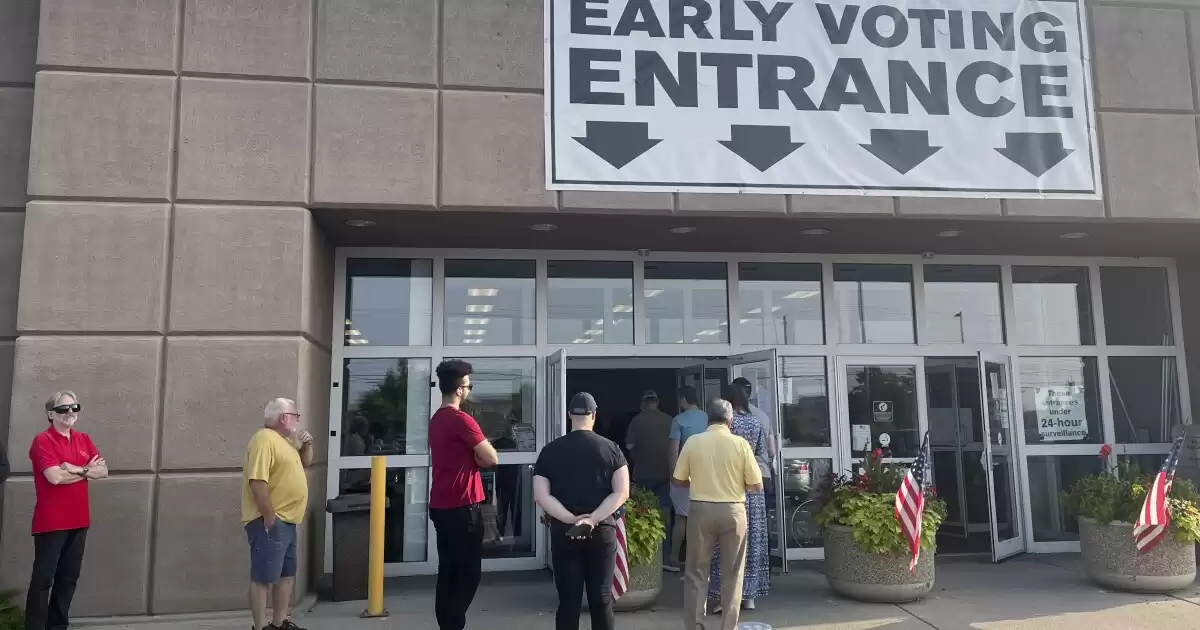"How many voters needed for majority? The controversy surrounding Ohio's Issue 1"
Ohio voters head to the polls for a special election over Issue 1, a measure to raise the threshold for voter approval of constitutional amendments.
COLUMBUS, Ohio -- Today, voters in Ohio will participate in a special election to decide on Issue 1, a ballot measure that aims to change the requirements for voter approval of amendments to the state's constitution. Currently, a simple majority is needed for an amendment to pass, but if Issue 1 is approved, it would raise the threshold to 60% approval.
The proposal for this measure came from Republican Secretary of State Frank LaRose, who argues that it is necessary to prevent wealthy out-of-state special interests from influencing Ohio's constitution. LaRose emphasizes the importance of taking the process of amending the constitution seriously, as it has long-term implications.
However, opponents of the referendum suspect that its timing is a deliberate attempt to hinder another constitutional amendment that is set to appear on the November ballot. This amendment would protect reproductive rights in the state constitution. The controversy surrounding this issue began when Ohio implemented a six-week abortion ban last summer, which led to a 10-year-old rape victim seeking an abortion in Indiana when Ohio doctors refused to provide the necessary treatment.
In response to the potential November amendment, Republican lawmakers, who hold a supermajority, were unable to include their 60% voter approval idea on the state's May primary ballot. Instead, they devised a new plan for an August special election. However, they faced a hurdle as they had previously voted to eliminate most August special elections in a law passed in December. LaRose, who supported the law, argued that this should not be an issue, stating that while he does not believe in holding elections in August as a regular practice, it is not unusual if the state legislature decides to do so.
Nonetheless, holding a statewide special election in August is indeed unusual, with the last occurrence dating back to 1926. In response to the proposal to raise the approval threshold, a large coalition emerged to oppose it. Hundreds of opponents gathered at the Statehouse in May to voice their concerns. Despite the protests, Republican lawmakers moved forward and even added a provision that would significantly increase the requirements for grassroots groups seeking to put amendments before voters. Under the new provision, these groups would need to collect signatures from all 88 counties in Ohio, compared to the current requirement of 44. This change would make it nearly impossible for grassroots organizations to successfully place amendments on the ballot, especially considering the size and rural nature of the state.
Even under the existing requirements, it is relatively rare for citizens and interest groups to successfully get amendments before voters. Since 1912, Ohio's constitution has been amended 172 times, but only 19 of those amendments originated from citizens or groups. Nevertheless, Republican supermajority lawmakers easily passed the plan, prompting Democrats and protestors to erupt in chants of "One person, one vote!" in the Ohio House chamber.
Opponents of Issue 1 filed a lawsuit, arguing that the resolution violates a law that prohibits most August special elections. However, in a party-line decision, the Ohio Supreme Court ruled that the law does not apply to state legislators putting forth a constitutional amendment for voter approval.
The coalition supporting Issue 1 primarily consists of anti-abortion organizations, gun rights groups, and major business groups in the state who are concerned about a forthcoming minimum wage amendment. On the other hand, the opposition includes union groups, advocates for abortion rights and gun law reform, as well as Ohio's four living ex-governors and five former attorneys general from both parties.
One of the leading voices against Issue 1 is Democratic former state Representative Mike Curtin, who criticizes the rushed nature of the proposal. He argues that it is a significant change to a 111-year-old right that Ohioans have had to amend their state constitution, making it nearly impossible to do so with a 60% threshold.
Despite being in the middle of the August vacation season when turnout is typically low, Ohioans have shown up for early voting. Some counties have reported long lines, and both sides of the issue have engaged in an advertising blitz, with a total expenditure of around $22 million, the majority of which came from outside Ohio.
In conclusion, Ohio voters are participating in a special election to decide on Issue 1, a ballot measure that would raise the approval threshold for future constitutional amendments. The proposal has generated controversy, with proponents arguing for the need to keep out-of-state interests at bay, while opponents suspect ulterior motives and potential hindrance to other amendments. The process has faced legal challenges, and a significant coalition has emerged to oppose the measure. The outcome of this election will have far-reaching implications for the state's constitution and the ability of citizens and interest groups to shape it in the future.











Comments on "How many voters needed for majority? The controversy surrounding Ohio's Issue 1"